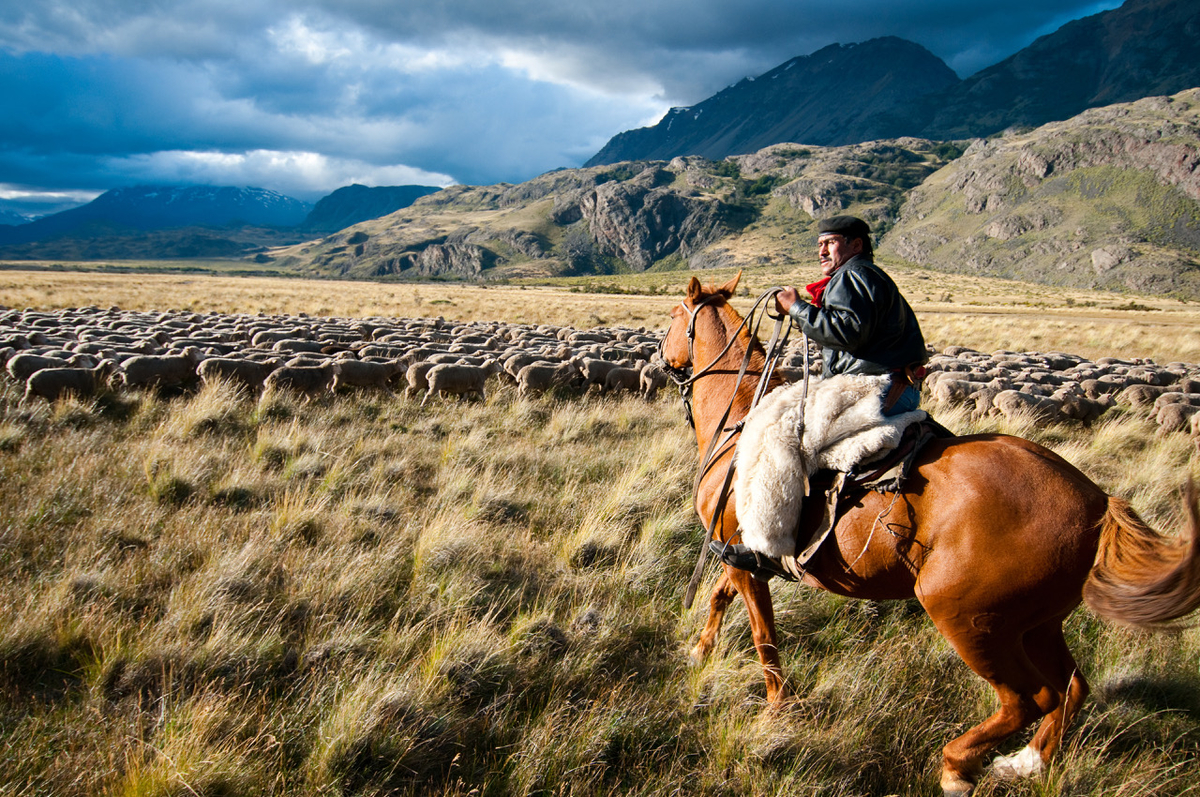 Gaucho Erasmo Betancur Casanova and his family herd the sheep and cattle that feed the staff at the Estancia Chacabuco, this estancia, previously one of the largest in Chilean Patagonia has become the new Patagonia National Park. The process of creating the park involves removing fences and most of the animals from the property to allow these grasslands to heal.
Gaucho Erasmo Betancur Casanova and his family herd the sheep and cattle that feed the staff at the Estancia Chacabuco, this estancia, previously one of the largest in Chilean Patagonia has become the new Patagonia National Park. The process of creating the park involves removing fences and most of the animals from the property to allow these grasslands to heal.
By Zoe Baillargeon
If its true that a picture tells a thousands words, then the work of photographer and documentarian
Bridget Besaw uses those thousand words and much more to advance environmental conservation.
After an award-winning career in newspaper and magazine photography for outlets like
Time,
Forbes, and the
New York Times, Besaw decided to refocus her energy on partnering with environmental non-profits through her company
Seedlight Pictures, which creates images and videos to help NGOs showcase their environmental work. A member of Patagon Journal’s Editorial Advisory Board, she is also a former resident of Pucon, Chile, a period in which she spent much time working in Patagonia. Among other projects in the region, she produced especially noteworthy images to raise awareness about the hydroelectric dam threats to the Baker and Pascua Rivers. She has also published two photography books,
Wildness Within Wildness Without and
From the Land.
Currently, Bridget is focused on directing and producing “
Rooted," a film that will examine the phenomenon of urban farming and food justice in the United States. As one of the judges of the
Fourth Patagonia Photo Contest, Patagon Journal spoke with Besaw from her home in Maine to discuss her time in Patagonia, how photography and images can raise awareness, and why, for environmental photographers, Chile is the place to be right now.
When did you first get into photography?
I’ve been doing it since I was in high school. I always wanted to be a photographer even when I was a kid.
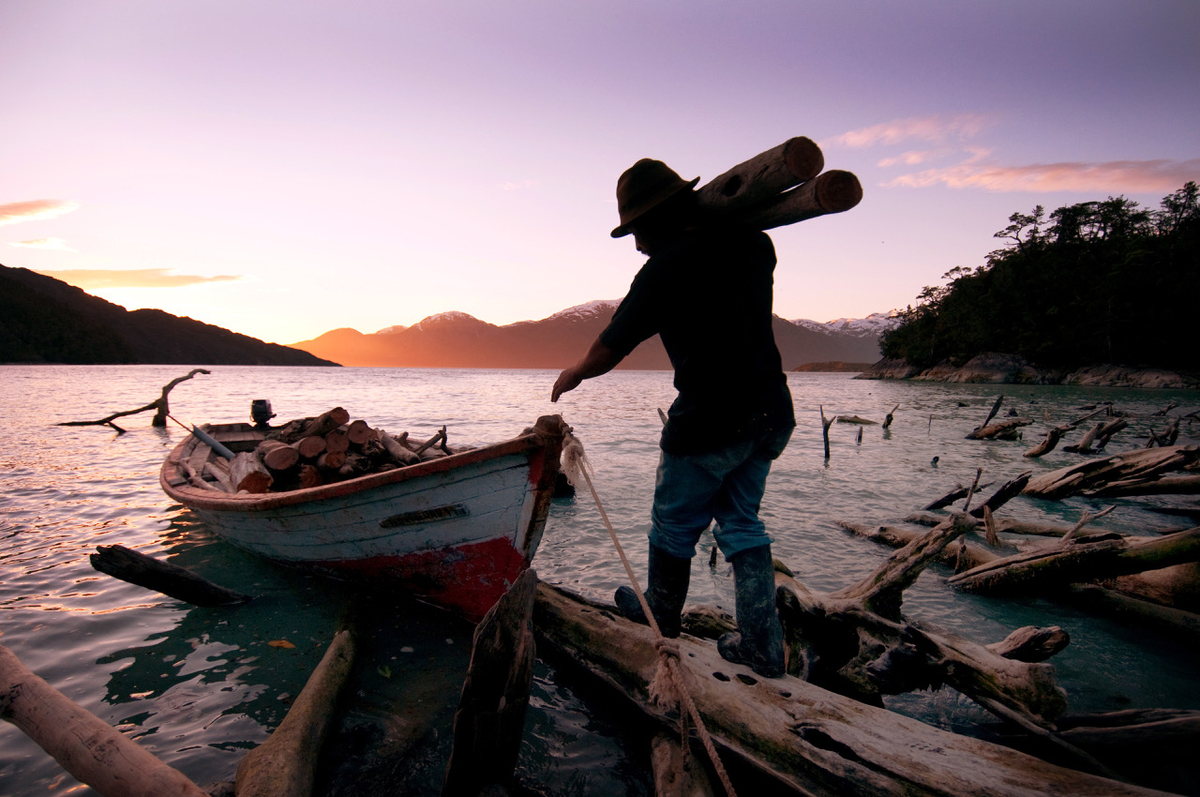 Augusto Hernandez is an activist from Tortel, Chile, which sits at the delta of the Baker River, downriver of where the proposed HydroAysen dams would have been. In the tiny town of Tortel, residents can either cut the dwindling resources of remaining cypress forest for fire wood, or they can collect the plentiful, renewable resource of drift wood from the many beaches just a short boat ride away.
Augusto Hernandez is an activist from Tortel, Chile, which sits at the delta of the Baker River, downriver of where the proposed HydroAysen dams would have been. In the tiny town of Tortel, residents can either cut the dwindling resources of remaining cypress forest for fire wood, or they can collect the plentiful, renewable resource of drift wood from the many beaches just a short boat ride away.
How did you get into environmental photography?
That shift came after 9/11. I was living in New York City and covered the tragedy pretty extensively. I just got a little burnt out, so I fled back to Maine, where I had spent most of my youth. I was looking for an alternative to the magazine stories that I had been working on, and I had always been an environmentalist at heart, so I thought what if I work for the actual organizations that are doing this great work on the ground instead of trying to convince magazines to tell these stories.
How is photography a special or unique medium for raising awareness about environmental issues?
I think photography has the ability to make change because images have an immediate emotional impact. People tend to instinctively feel like a photograph represents the truth, and so if images can move them to emotionally care about something, then they can be spurred into action. Good photographs are just a quicker hit. They can really gut-punch you in an instant. Seeing a photograph can tap into a part of the brain and access emotions in a way that nothing else does.
For filmmaking, we live in a moment right now when streaming content is more widely available, and on different platforms. The way we watch content has so expanded over the last decade, that people are now watching a lot more movies than ever before. And the data shows that they’re watching documentary films more than ever. Also, this is a time when mainstream media is certainly not what most of us wish it was in terms of giving us the kind of information we need to make good choices. So I think independently made documentary films have huge potential as a part of the pie in how we get our information, and that’s just very exciting.
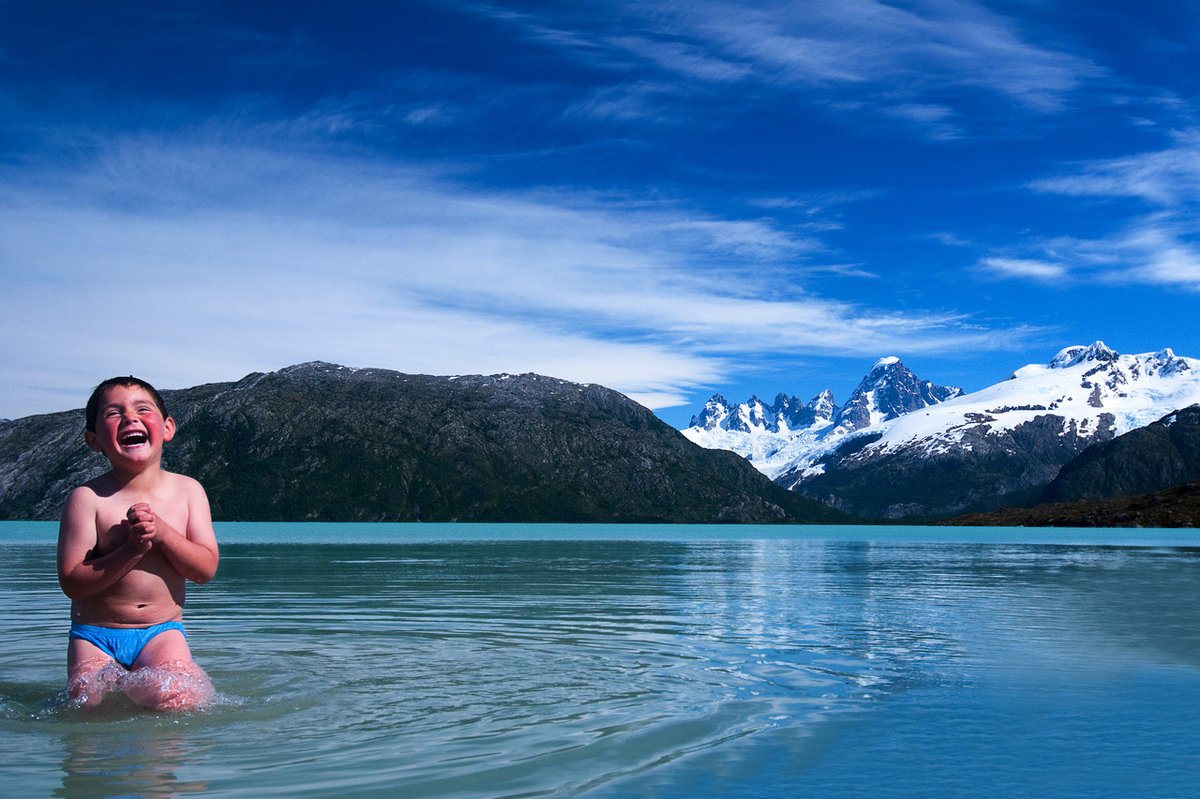 Juan Jose Soto (age 4) playing in the icy glacial waters of Lake O’Higgins. The place Juan is playing would be have been flooded if the dams had been built.
Juan Jose Soto (age 4) playing in the icy glacial waters of Lake O’Higgins. The place Juan is playing would be have been flooded if the dams had been built.
Tell us about your work in Patagonia. Do you have a favorite place there to photograph?
I initially wound up in Patagonia National Park traveling with some friends, there I met Doug and Kris Tompkins and just fell in love with their project. That was a long time ago, I think it might have been ten or more years ago. Then I continued to return to the park to document that story; I made some photographs and a video that the Patagonia clothing company utilized. And then I also worked for Patagonia Sur, which is a Chile-based company that does conservation real estate in the south. And then just being in love with the place, I traveled down there a lot. That’s my general history working in the region.
For favorite places, I’m a coastal person, so honestly I can’t decide between Patagonia National Park and Melimoyu. They’re both beautiful places, but since I tend to gravitate toward the ocean, I think that Melimoyu and that coastal region of the south holds a special place in my heart for it’s unique landscape. It’s like a prehistoric dream meets marine wonderland.
One of your past projects focused on the potential impacts to local communities from the two large-scale hydroelectric dams that had been planned for the Aysen region of Chilean Patagonia. Can you tell us more about that project and what the experience was like?
That was a project commissioned by the International League of Conservation Photographers (ILCP), back when they used to gather together a group of photographers to work on one issue in a one or two week period. Initially, I went to check out the park and then because I knew about this issue and had been to the region I was chosen to do this ILCP project. It was an emotional story that felt very David and Goliath, where a region with a small population was coming up against some incredibly powerful global forces. But in the end, we won! So it’s been an inspiring story for people all over the world; a reminder that if we fight hard enough, we can actually win some of these battles that we think we may never win against corporate and political interests, and corruption. Of course, southern Chile faces many other challenges, too. The salmon farming industry in that region is very troublesome to me. The utter and complete destruction of marine environments and the danger of farmed salmon to one’s health is a huge problem that I hope Chilean photographers and filmmakers are tackling.
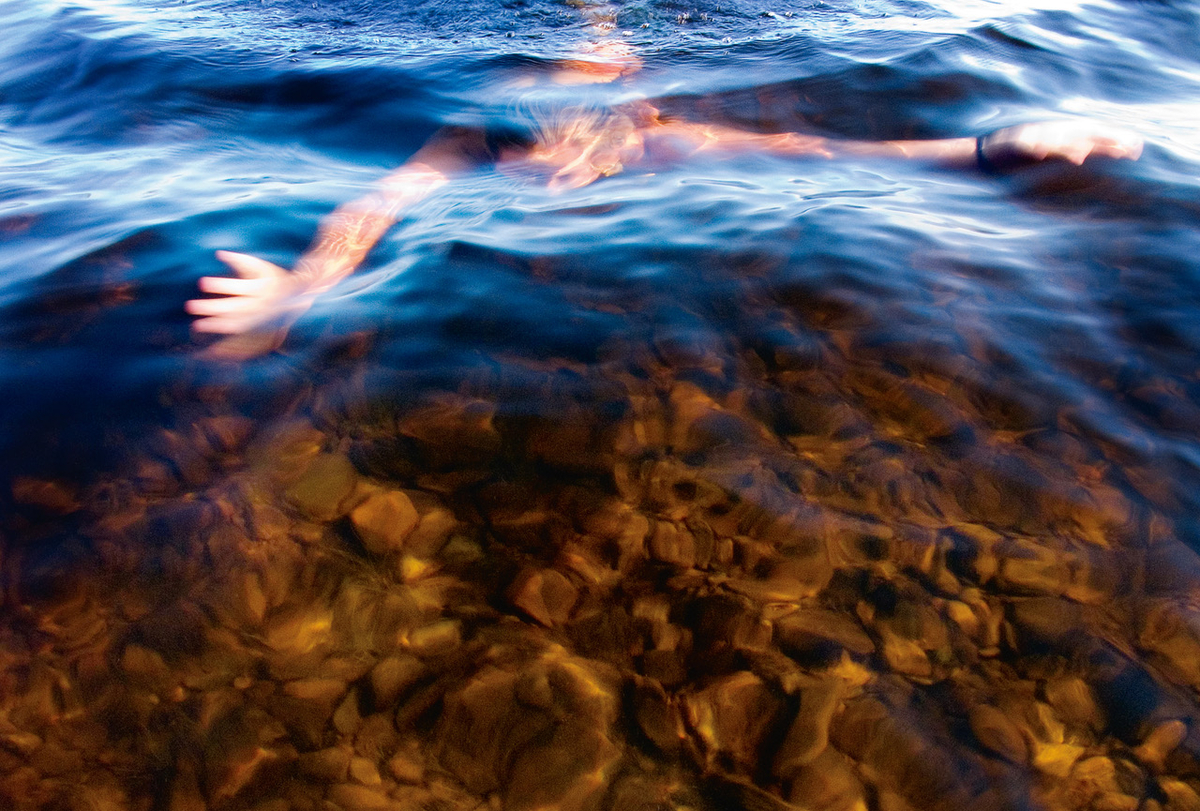 A girl swims in a remote lake in Northern Maine while traveling on a three week canoe adventure with the Chewonki Wilderness Trip for Girls.
A girl swims in a remote lake in Northern Maine while traveling on a three week canoe adventure with the Chewonki Wilderness Trip for Girls.
Since you have photographed both the nature and peoples of Patagonia, which do you find the most compelling, or which leaves the biggest impression?
If I had to choose between people or landscape, I’ll always choose people because ultimately I think they both walk hand in hand, especially in Patagonia. Those are people of the land, literally of that place. So I almost wouldn’t separate them. I think they belong together.
On your website, it says that you’re on a life-long quest to evoke deja vu? What do you mean by that, and how do you accomplish it?
Haha, I probably need to edit that bio! What I meant when I wrote that was I believe that we all innately feel connected to nature but we live in a moment in human history when we’ve forgotten how very connected we actually are to nature and to the planet. I want my work to be similar to a “deja vu,” to remind us of that connection. As in, I’ve been here before...I know this place...and so I want to protect it.
What, in your opinion, makes a really great photograph stand out?
I like photographs where everything comes together. When moment and composition and light and even energy - there’s always an energy to the right moment - when those things all come together, that’s what makes a great photograph for me.
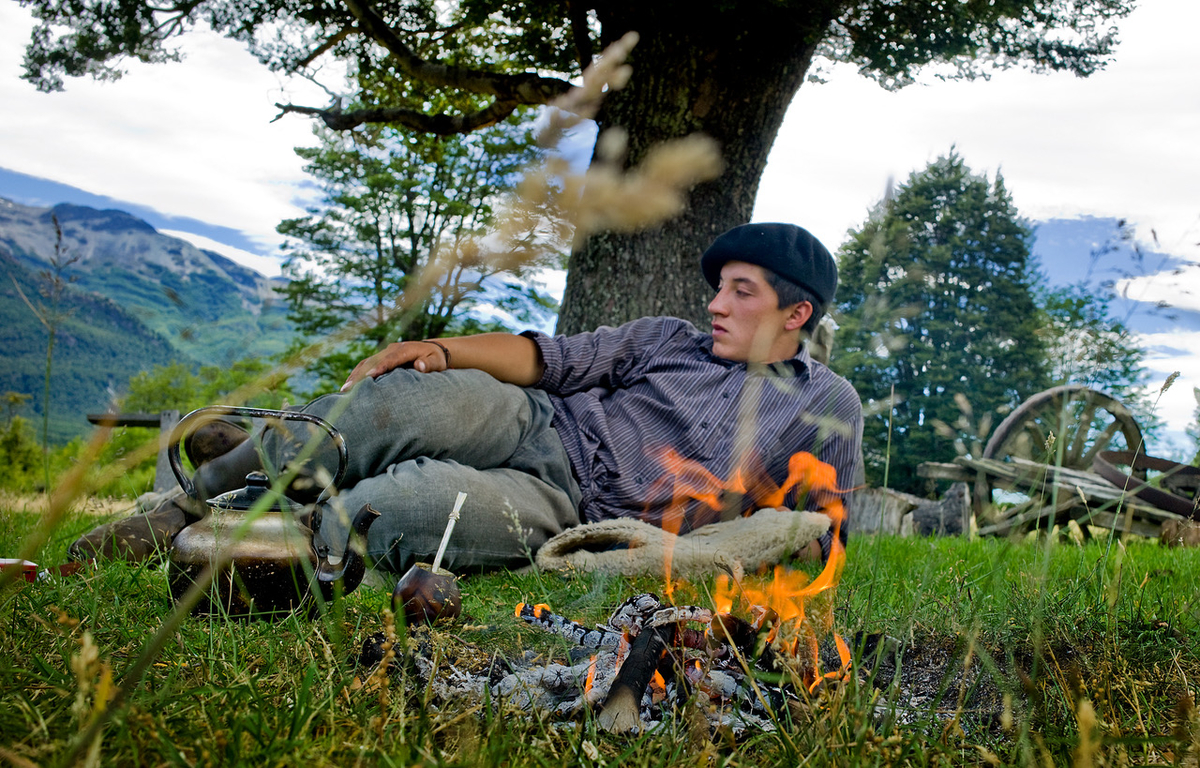 A young gaucho rests after a day of measuring saplings with researchers. His father and grandfather burned the trees in the region to make way for grazing, but his generation of Patagonian’s is now a part of protecting the forests and helping them to regenerate to encourage other forms of economy like tourism.
A young gaucho rests after a day of measuring saplings with researchers. His father and grandfather burned the trees in the region to make way for grazing, but his generation of Patagonian’s is now a part of protecting the forests and helping them to regenerate to encourage other forms of economy like tourism.
Do you have any advice for aspiring nature or sustainability photographers?
My advice is two-fold. I would say in Chile, aspiring photographers have really great opportunities in a moment when conservation and environmental ethic, especially among the younger generation, is just barreling ahead. I would jump on the chance to be one of the storytellers of that powerful new movement. For much of my work in Patagonia I had Chilean photographer and filmmaker Daniel Casado assisting me in the field work, and he has gone on to tackle many critical conservation stories in Chile like salmon farming and other water resource issues. I think it's important for Chilean orgs to realize some of the amazing talent they have in photographers like Dani and that there is a growing community of environmentally minded Chilean storytellers available to them. And along those same lines, for anyone anywhere, not just in Chile, to choose the environmental story that most speaks to you— the thing that you’re most concerned about, then find an organization that is also working on that issue and approach them with an idea or a project. Start small and build up a portfolio through working with organizations that are doing good work on the issues that are most meaningful to you.
Do you have any new upcoming projects you’d like to tell us about?
Right now, I’m working on a film project called “
Rooted." It’s about urban farming and food justice and how the corporate food systems in the United States — and frankly in Chile and all over the world — are systematically choosing profit over public health and wellbeing. It’s about how those systems are designed to be disproportionately damaging to the most vulnerable poor communities as an intentional form of racism and oppression. If you can’t get access to healthy food, that's a non-starter. If commodity or processed or pesticide-laden food is all that is available and affordable, you are much more likely to become ill with a chronic disease or to be in poor health, which keeps people from making good choices for themselves and their families. Its funny, early in my career as an environmental documentarian, I never would have thought that food would become such a focus of my work, but I’m beginning to think it may be the single most important environmental issue that I can tackle. Everyone eats. It affects everyone, and if it’s not done well, food can be very damaging to our bodies and to the planet. But the good news is, the opposite is also true. If we as documentarians can help the public to become aware of how critical it is to eat healthy, whole food that is grown with care for the planet, then this one act can reverse the tide of damage and bring us closer to wellness, connection and happiness.
 Gaucho Erasmo Betancur Casanova and his family herd the sheep and cattle that feed the staff at the Estancia Chacabuco, this estancia, previously one of the largest in Chilean Patagonia has become the new Patagonia National Park. The process of creating the park involves removing fences and most of the animals from the property to allow these grasslands to heal.
Gaucho Erasmo Betancur Casanova and his family herd the sheep and cattle that feed the staff at the Estancia Chacabuco, this estancia, previously one of the largest in Chilean Patagonia has become the new Patagonia National Park. The process of creating the park involves removing fences and most of the animals from the property to allow these grasslands to heal.  Augusto Hernandez is an activist from Tortel, Chile, which sits at the delta of the Baker River, downriver of where the proposed HydroAysen dams would have been. In the tiny town of Tortel, residents can either cut the dwindling resources of remaining cypress forest for fire wood, or they can collect the plentiful, renewable resource of drift wood from the many beaches just a short boat ride away.
Augusto Hernandez is an activist from Tortel, Chile, which sits at the delta of the Baker River, downriver of where the proposed HydroAysen dams would have been. In the tiny town of Tortel, residents can either cut the dwindling resources of remaining cypress forest for fire wood, or they can collect the plentiful, renewable resource of drift wood from the many beaches just a short boat ride away.  Juan Jose Soto (age 4) playing in the icy glacial waters of Lake O’Higgins. The place Juan is playing would be have been flooded if the dams had been built.
Juan Jose Soto (age 4) playing in the icy glacial waters of Lake O’Higgins. The place Juan is playing would be have been flooded if the dams had been built. A girl swims in a remote lake in Northern Maine while traveling on a three week canoe adventure with the Chewonki Wilderness Trip for Girls.
A girl swims in a remote lake in Northern Maine while traveling on a three week canoe adventure with the Chewonki Wilderness Trip for Girls. A young gaucho rests after a day of measuring saplings with researchers. His father and grandfather burned the trees in the region to make way for grazing, but his generation of Patagonian’s is now a part of protecting the forests and helping them to regenerate to encourage other forms of economy like tourism.
A young gaucho rests after a day of measuring saplings with researchers. His father and grandfather burned the trees in the region to make way for grazing, but his generation of Patagonian’s is now a part of protecting the forests and helping them to regenerate to encourage other forms of economy like tourism.
